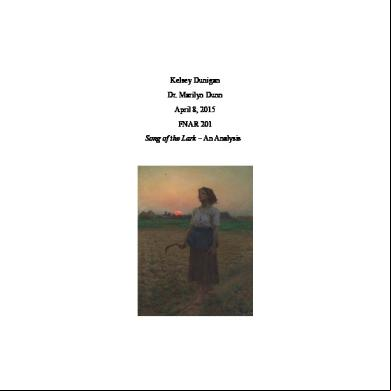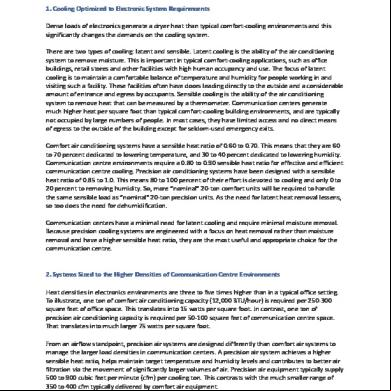Conservation Of The Liben Lark 275q39
This document was ed by and they confirmed that they have the permission to share it. If you are author or own the copyright of this book, please report to us by using this report form. Report 3b7i
Overview 3e4r5l
& View Conservation Of The Liben Lark as PDF for free.
More details w3441
- Words: 647
- Pages: 25
Conservation of the Endemic Liben Lark in Southern Ethiopia
Yilma Dellelegn Abebe Ethiopian Wildlife & Natural History Society
Introduction • • • • •
Description of species History and Natural History Conservation work – threats Challenges Future
The Liben Lark - Description • Unique amongst larks. • Long legs, Long hind toes, long necks and small almost triangular shaped head. • Believed to be the ancestor to other lark species and therefore primitive.
The Liben Lark – Natural History • Weak fluttering flight • Soft flight feathers • Pencil thin tails and brief aerial song displays • Unable to retract its long hind claws. • Range is tiny (not more than 40 sq km) • One of 32 endemic species in Ethiopia
The Liben Lark - History • Discovered first in 1968 by Christian Erard. • Its status as a new species to science was recognized in 1975. • Rediscovered back in 2001. • Used to be known as the Sidamo Long-clawed Lark • Its status was not known until 2007 when a series of surveys were conducted.
The Liben Lark - History • Currently with a population of not more than 200 individuals and a number of threats it is listed as critically endangered.
History • Surveys in 2007 confirmed a number of things. – Its range previously estimated at 750 sq km was only 40 sq km. – Its population previously thought to be about 2000 birds was estimated to between 90-256 individuals.
Long grass on the Liben plains – Ideal habitat for the Liben Lark
Liben Lark – Natural History • Very little is known of this endangered and endemic species. • Its eggs were first seen and described in 2007 by a group of Ethiopian & British scientists. • It lays its eggs on the ground usually under a small herb or clump of grass.
Threats
Threat 1 - Agriculture
Threats 1- Agriculture
Threats 2- Overgrazing
Bare areas formed by ants
Threats 2 - Overgrazing
Threat 3 - Bush infestation Areas with bush and scrub growth
Overgrazed but still fair habitat for the Liben Lark
Threat 4 – Donkey Carts and Paths Donkey carts are commonly used for transport on the Dida Liben
Continual use creates paths (scars on the plains)
Conservation work Consulting local people during all steps of conservation action insures success
Conservation work Bush infestation decreases grazing areas and habitat for birds
Bush clearing by local people to increase pasture and habitat for birds
Conservation work Section of the plains cleared of bush and scrub – more suitable as a habitat for the Liben Lark
Conservation work Former experimental enclosure of 4 ha
A closer view of the enclosure
Conservation work Enclosure made by locals
Detail of the fencing with thorn branches
Challenges • Creating rapport with local communities takes lots of time • Finding commitment in people • Too many stakeholders to deal with • Project is always limited in time • Expectation from an NGO is high • Policies are not ive
Future • More time is needed to see change _ Projects are always limited to a few years time. • We must ensure sustainability of the project – Sustainability has different meanings. It can be associated to our lifestyle. Using no more than our fair share of the planet’s resources. It is also associated to balancing our needs to the needs of the environment. It can mean living in harmony with the immediate environment we live in.
Future • One good way of ensuring sustainability is to hand over the project slowly to local people – Establishing a site group. – Establishing a concern group that would stand for the environment. – Coming up with a system where local people generate a livelihood from nature.
The End • Picture credits – Cagan Sekercioglu – Amano Samarpan – Mengistu Wondafrash – Paul Donald – Yilma Dellelegn
Yilma Dellelegn Abebe Ethiopian Wildlife & Natural History Society
Introduction • • • • •
Description of species History and Natural History Conservation work – threats Challenges Future
The Liben Lark - Description • Unique amongst larks. • Long legs, Long hind toes, long necks and small almost triangular shaped head. • Believed to be the ancestor to other lark species and therefore primitive.
The Liben Lark – Natural History • Weak fluttering flight • Soft flight feathers • Pencil thin tails and brief aerial song displays • Unable to retract its long hind claws. • Range is tiny (not more than 40 sq km) • One of 32 endemic species in Ethiopia
The Liben Lark - History • Discovered first in 1968 by Christian Erard. • Its status as a new species to science was recognized in 1975. • Rediscovered back in 2001. • Used to be known as the Sidamo Long-clawed Lark • Its status was not known until 2007 when a series of surveys were conducted.
The Liben Lark - History • Currently with a population of not more than 200 individuals and a number of threats it is listed as critically endangered.
History • Surveys in 2007 confirmed a number of things. – Its range previously estimated at 750 sq km was only 40 sq km. – Its population previously thought to be about 2000 birds was estimated to between 90-256 individuals.
Long grass on the Liben plains – Ideal habitat for the Liben Lark
Liben Lark – Natural History • Very little is known of this endangered and endemic species. • Its eggs were first seen and described in 2007 by a group of Ethiopian & British scientists. • It lays its eggs on the ground usually under a small herb or clump of grass.
Threats
Threat 1 - Agriculture
Threats 1- Agriculture
Threats 2- Overgrazing
Bare areas formed by ants
Threats 2 - Overgrazing
Threat 3 - Bush infestation Areas with bush and scrub growth
Overgrazed but still fair habitat for the Liben Lark
Threat 4 – Donkey Carts and Paths Donkey carts are commonly used for transport on the Dida Liben
Continual use creates paths (scars on the plains)
Conservation work Consulting local people during all steps of conservation action insures success
Conservation work Bush infestation decreases grazing areas and habitat for birds
Bush clearing by local people to increase pasture and habitat for birds
Conservation work Section of the plains cleared of bush and scrub – more suitable as a habitat for the Liben Lark
Conservation work Former experimental enclosure of 4 ha
A closer view of the enclosure
Conservation work Enclosure made by locals
Detail of the fencing with thorn branches
Challenges • Creating rapport with local communities takes lots of time • Finding commitment in people • Too many stakeholders to deal with • Project is always limited in time • Expectation from an NGO is high • Policies are not ive
Future • More time is needed to see change _ Projects are always limited to a few years time. • We must ensure sustainability of the project – Sustainability has different meanings. It can be associated to our lifestyle. Using no more than our fair share of the planet’s resources. It is also associated to balancing our needs to the needs of the environment. It can mean living in harmony with the immediate environment we live in.
Future • One good way of ensuring sustainability is to hand over the project slowly to local people – Establishing a site group. – Establishing a concern group that would stand for the environment. – Coming up with a system where local people generate a livelihood from nature.
The End • Picture credits – Cagan Sekercioglu – Amano Samarpan – Mengistu Wondafrash – Paul Donald – Yilma Dellelegn










